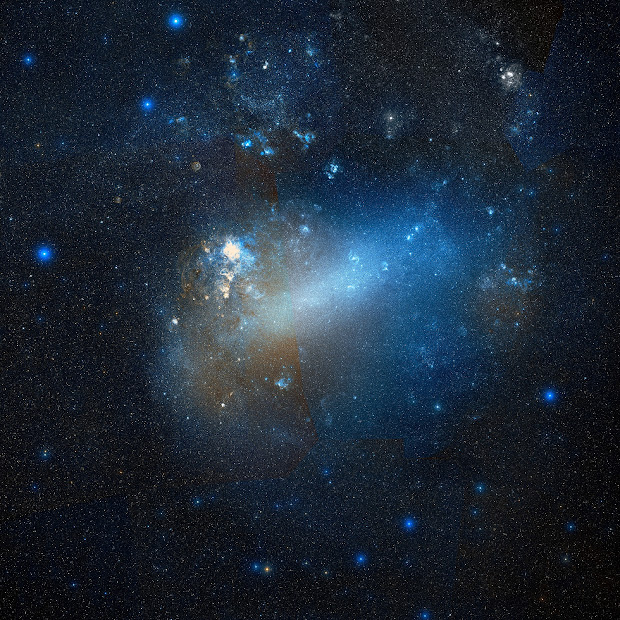Click on the image for full resolution (3.45 MB)
This new DSS2 image shows the Large Magellanic Cloud (LMC). The Large Magellanic Cloud is a nearby irregular galaxy, and is a satellite of the Milky Way. At a distance of slightly less than 50 kiloparsecs (≈160,000 light-years), the LMC is the third closest galaxy to the Milky Way, with the Sagittarius Dwarf Spheroidal (~ 16 kiloparsecs) and Canis Major Dwarf Galaxy (~ 12.9 kiloparsecs) lying closer to the center of the Milky Way. It has a mass equivalent to approximately 10 billion times the mass of our Sun (10^10 solar masses), making it roughly 1/100 as massive as the Milky Way, and a diameter of about 14,000 light-years. The LMC is the fourth largest galaxy in the Local Group, the first, second and third largest places being taken by Andromeda Galaxy (M31), our own Milky Way Galaxy, and the Triangulum Galaxy (M33), respectively. While the LMC is often considered an irregular type galaxy (the NASA Extragalactic Database lists the Hubble sequence type as Irr/SB(s)m), the LMC contains a very prominent bar in its center, suggesting that it may have previously been a barred spiral galaxy. The LMC's irregular appearance is possibly the result of tidal interactions with both the Milky Way, and the Small Magellanic Cloud (SMC). The very first recorded mention of the Large Magellanic Cloud was by the Persian astronomer, Abd Al-Rahman Al Sufi (later known in Europe as "Azophi"), in his Book of Fixed Stars around 964 AD. The next recorded observation was in 1503–4 by Amerigo Vespucci in a letter about his third voyage. In this letter he mentions "three Canopes, two bright and one obscure"; "bright" refers to the two Magellanic Clouds, and "obscure" refers to the Coalsack. Ferdinand Magellan sighted the LMC on his voyage in 1519, and his writings brought the LMC into common Western knowledge. The galaxy now bears his name.
The full resolution image weighs 3.45 MB, so please be patient when downloading!
Credit: Caltech/DSS2/Wikisky.org
Processing: Jean-Baptiste Faure










2 comment(s):
Good article needing a fine tune with the numbers. ....It should read : "It has a mass equivalent to approximately 10 billion times the mass of our Sun (10^10 solar masses),...." Cheers, Rick Swan.
Thank you Rick! Typo corrected!
Cheers, Jean-Baptiste.
Post a Comment